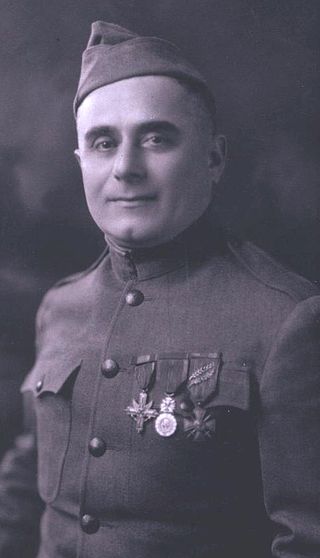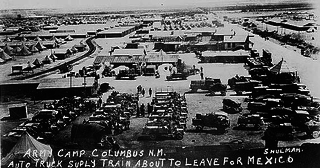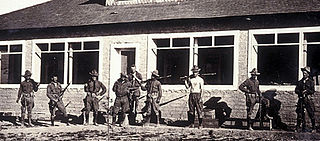
Francisco "Pancho" Villa was a Mexican revolutionary and prominent figure in the Mexican Revolution. He was a key figure in the revolutionary movement that forced out President Porfirio Díaz and brought Francisco I. Madero to power in 1911. When Madero was ousted by a coup led by General Victoriano Huerta in February 1913, Villa joined the anti-Huerta forces in the Constitutionalist Army led by Venustiano Carranza. After the defeat and exile of Huerta in July 1914, Villa broke with Carranza. Villa dominated the meeting of revolutionary generals that excluded Carranza and helped create a coalition government. Emiliano Zapata and Villa became formal allies in this period. Like Zapata, Villa was strongly in favor of land reform, but did not implement it when he had power.

Emilio Ivan Kosterlitzky was a Russian-born Mexican colonel during the Mexican Revolution. He had also served in the Mexican Apache Wars and Yaqui Wars. He is most noted for being the commander of the Mexican Rurales, or border police, during the late 19th century.

Samuel Dreben, sometimes misspelled "Drebben" or "Drebin", and known as "The Fighting Jew", was a highly decorated soldier in the US Army and a mercenary who fought in a variety of wars and revolutions.

José Inés Salazar was a Mexican revolutionary general who led the Orozquistas during the Mexican Revolution and later fought with Pancho Villa. He was a native of Casas Grandes, Chihuahua.

The Village of Columbus and Camp Furlong is a National Historic Landmark District commemorating the 1916 raid by Pancho Villa on the town of Columbus, New Mexico, and the American military response to that raid, the "Punitive Expedition" led by General John J. Pershing. The raid and its response, set during World War I, the Mexican Revolution, and an accompanying low-level Border War, played a significant role in diplomacy and military preparedness for eventual American entry in the World War. The district encompasses buildings that survived the raid, and military facilities used in the American response. The landmark designation was made in 1975.

The Battle of Columbus, also known as the Burning of Columbus or the Columbus Raid, began on March 9, 1916, as a raid conducted by remnants of Pancho Villa's Division of the North on the small United States border town of Columbus, New Mexico, located 3 miles (4.8 km) north of the border with Mexico. The raid escalated into a full-scale battle between Villistas and the United States Army.

The First Battle of Ciudad Juárez took place in April and May 1911 between federal forces loyal to President Porfirio Díaz and rebel forces of Francisco Madero, during the Mexican Revolution. Pascual Orozco and Pancho Villa commanded Madero's army, which besieged Ciudad Juárez, Chihuahua. After two days of fighting the city's garrison surrendered and Orozco and Villa took control of the town. The fall of Ciudad Juárez to Madero, combined with Emiliano Zapata's taking of Cuautla in Morelos, convinced Díaz that he could not hope to defeat the rebels. As a result, he agreed to the Treaty of Ciudad Juárez, resigned and went into exile in France, thus ending the initial stage of the Mexican Revolution.

The Mexican Border War, also known as the Border Campaign, refers to a series of military engagements which took place between the United States military and several Mexican factions in the Mexican–American border region of North America during the Mexican Revolution. It was the last major conflict fought on U.S. soil.

The raid on Glenn Springs occurred on the night of May 5–6, 1916, when Mexican Villistas and Carrancistas attacked the towns of Boquillas and Glenn Springs, Texas. In Glenn Springs, the raiders burned several buildings and fought a three-hour battle with a small force of American soldiers who were stationed there. At the same time, a second party of rebels robbed a general store and a silver mine in Boquillas. Four Americans were killed and the rebels took two hostages to Coahuila. In response to the attack, the United States Army launched a short punitive expedition into Mexico, fought with the rebels, and rescued the captives.

The Third Battle of Ciudad Juarez, or simply the Battle of Juarez, was the final major battle involving the rebels of Francisco "Pancho" Villa. It began on June 15, 1919, when Villa attempted to capture the border city of Ciudad Juarez from the Mexican Army. During the engagement the Villistas provoked an intervention by the United States Army protecting the neighboring city of El Paso, Texas. The Americans routed the Villistas in what became the second largest battle of the Mexican Revolution involving the US, and the last battle of the Border War. With the American army closing in, the Villistas had no choice but to retreat. Pancho Villa then attacked Durango but lost again, so he retired to his home at Parral, Chihuahua in 1920, with a full pardon from the Carrancista government.
Felix A. Sommerfeld was a German secret service agent in Mexico and the United States between 1908 and 1919. He was chief of the Mexican secret service under President Francisco I. Madero, worked as a diplomat and arms buyer for Venustiano Carranza and Francisco "Pancho" Villa, and ran the Mexican portion of Germany's war strategy in North America between 1914 and 1917.

Emil Lugwig "Lewis" Holmdahl was an American soldier of fortune, infantryman, machine gunner, spy, gun runner, and treasure hunter who fought under Frederick Funston and John J. Pershing in the Spanish–American War and subsequent Philippine–American War, under Lee Christmas in Central America, under Francisco Madero, Pancho Villa, and Venustiano Carranza in the Mexican Revolution, and under John J. Pershing again in World War I. In 1926, Holmdahl was accused of having stolen Francisco "Pancho" Villa's head.
The Raid on Mazatlán Railway was a raid launched by supporters of General Francisco I. Madero against the Mazatlán Railway held by supporters of Porfirio Díaz, under the command of the American soldier of fortune, Emil Lewis Holmdahl.
The Costa Oeste Campaign was a military campaign during the opening stages of the Mexican Revolution, in which the federal government of Mexican president Porfirio Díaz and the commander of the Rurales, Emilio Kosterlitzky, who faced off against supporters of the American soldier of fortune, Emil Lewis Holmdahl.
The Raid on Buena Noche was a raid during the Mexican Revolution where supporters of the American soldier of fortune Emil Lewis Holmdahl, raided the Buena Noche Mine, near Rosario.
The Capture of Rosamorada was an action during the Mexican Revolution, where two rebel commanders, Martín Espinosa and the American soldier of fortune, Emil Lewis Holmdahl captured the government stronghold of Rosamorada.
The Battle of Tepic was an engagement during the Mexican Revolution where two formers allies Emil Lewis Holmdahl and Martín Espinosa, turned enemies fought for control over the provincial capital of Tepic.
The Battle of Parque was a battle during the Mexican Revolution, where Emiliano Zapata and his supporters rebelling against president Francisco I. Madero, who had recently overthrown the previous president Porfirio Díaz. A group of Zapata's supporters attempted to ambush a train containing 27 Mexican Rurales under the command of the American Soldier of Fortune, Emil Lewis Holmdahl.
The Battle of Cuernavaca was a battle during the Mexican Revolution, where Emiliano Zapata and his supporters rebelling against president Francisco I. Madero, who had recently overthrown the previous president Porfirio Díaz. Zapata was patrolling around his stronghold in the hills of Cuernavaca, where he was ambushed by a government force of Rurales under the command of the American Soldier of Fortune, Emil Lewis Holmdahl.
The Battle of San Andrés, also known as the Charge at San Andrés, took place during the Mexican Revolution and was fought on August 26–27, 1913. Revolutionary leader General Pancho Villa attacked the town of San Andrés, and the battle concluded when the American soldier of fortune charged the federal positions and routed the enemy. A thousand government soldiers were killed, and 400 prisoners were executed by Villa's self styled executioner, Rodolfo Fierro.










